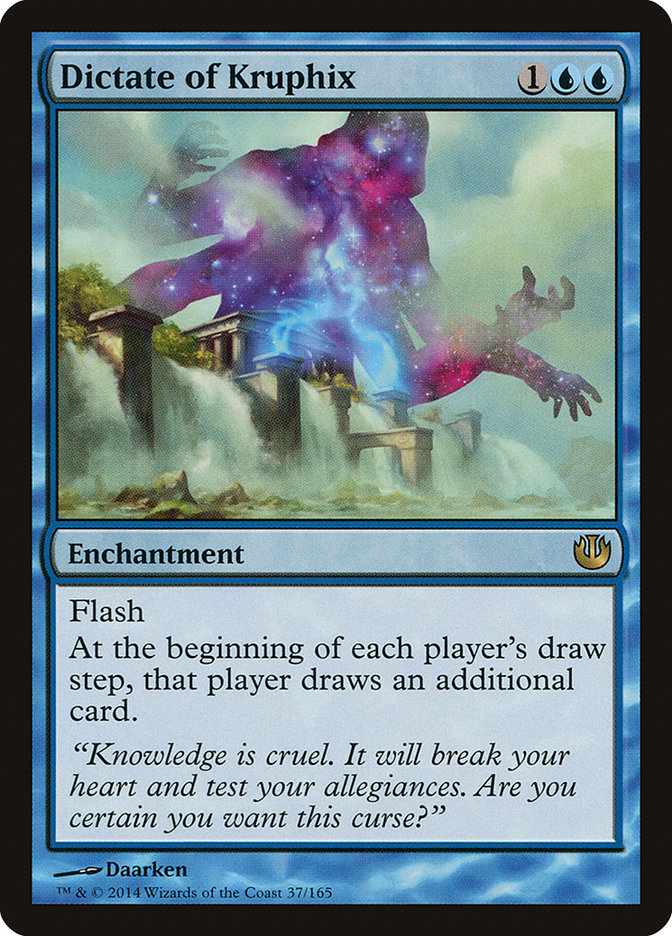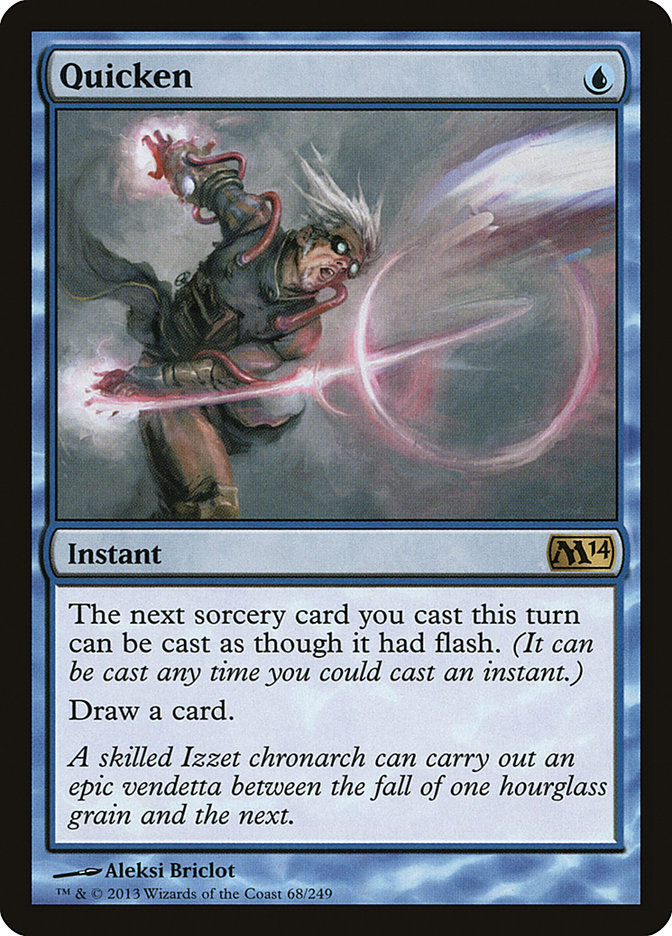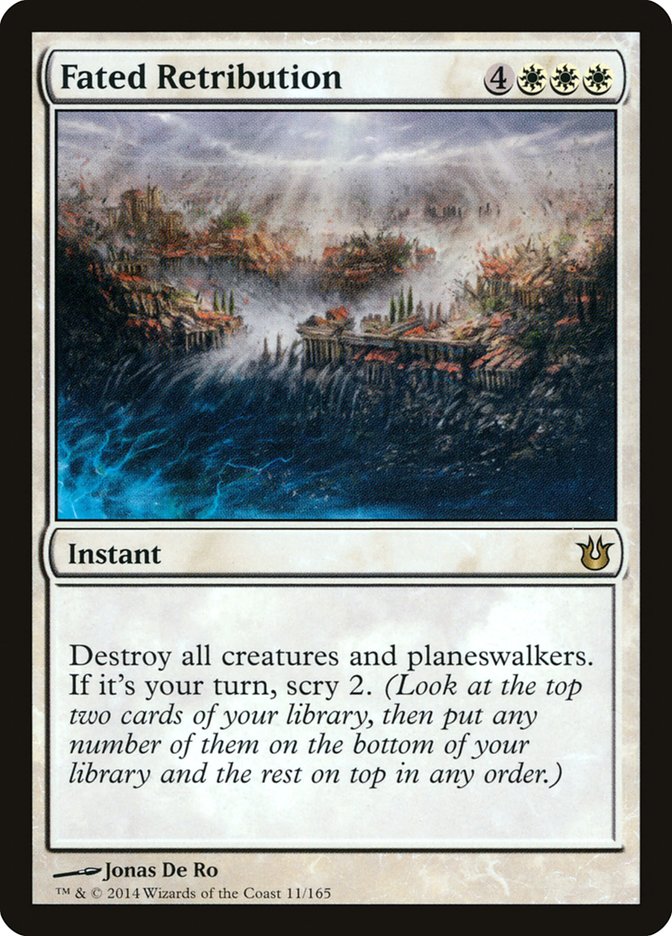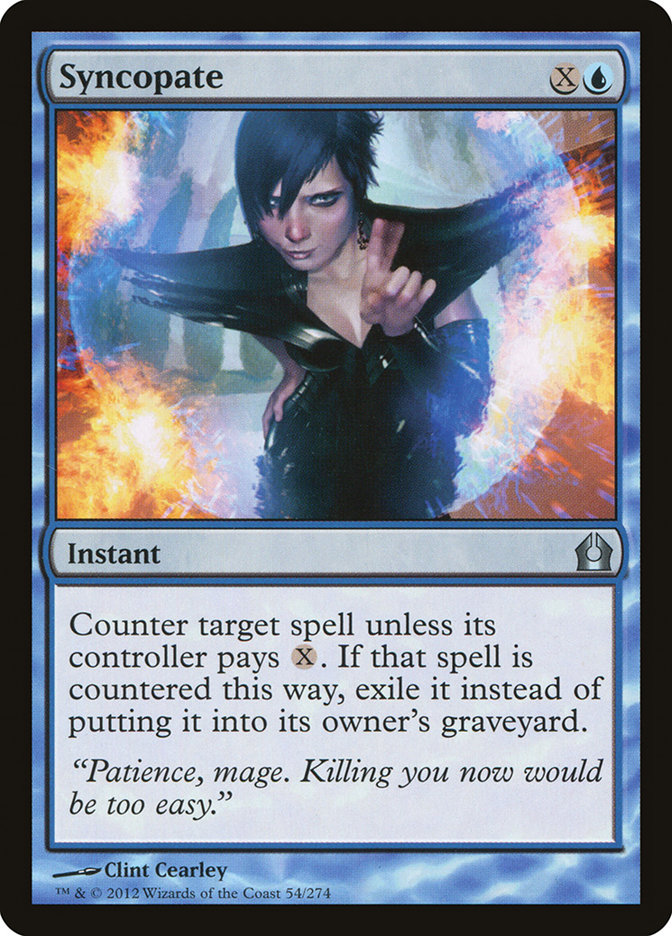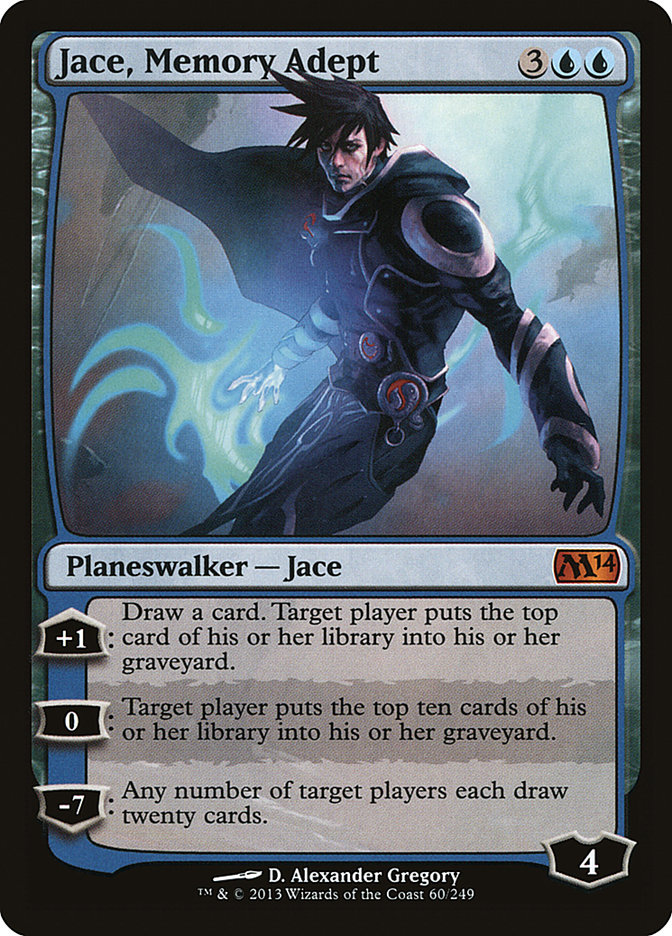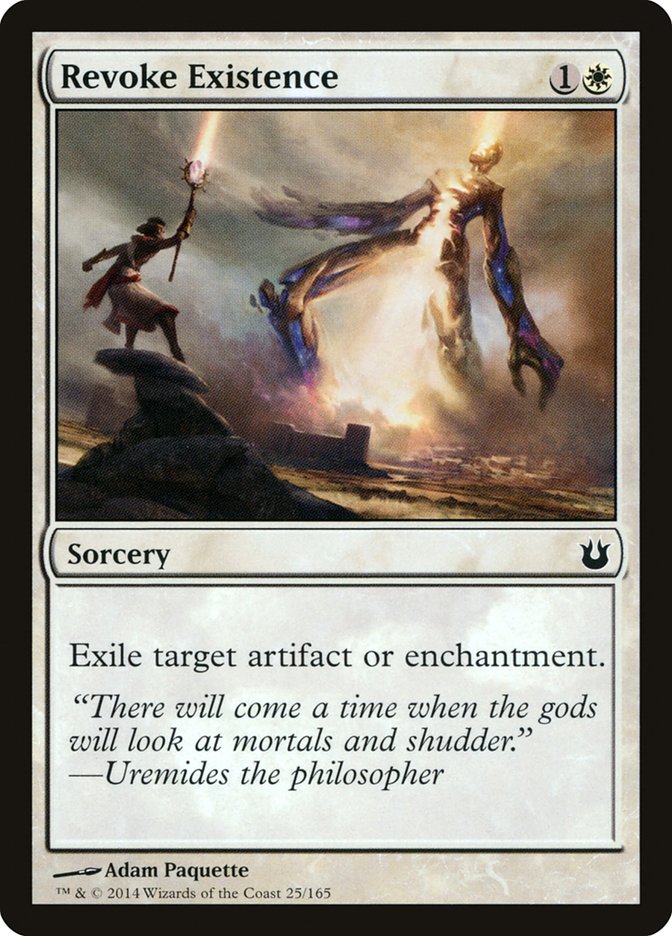If you love playing control decks, go preorder four of these right now. You’ll thank me later.
Ever since I first got to play with Dictate of Kruphix, I’ve been . . . intrigued. Yes, the card is beneficial for both players, but what is the actual cost of casting Divination for free every turn? Your opponent will never run out of gas, but the same is true for you if you’ve built your deck correctly. After all, Sphinx’s Revelation is a powerful Magic card and can usually help you find whatever answers you need regardless of how many threats the opponent might present.
If you haven’t yet, go watch the Versus video from Monday where I played Turbo Fog. From those five games I learned quite a bit about Dictate of Kruphix as well as the direction I want to take control in the new Standard. Dictate of Kruphix is quite powerful, as it gives you the ability to fight through a ton of hand disruption and can potentially act as a way to deck your opponent in a reasonable amount of time alongside Elixir of Immortality.
The fact of the matter is that the card Fog is not a good way to stall out your opponents. The right way is a card that is already seeing regular play in U/W Control decks and lets me do exactly what I want to do: play all of my spells on my opponent’s turn.
Quicken into Supreme Verdict is one of the most powerful plays in Standard at the moment, but so few control decks are playing it. I understand that this is a two-card combo that doesn’t win the game. I also understand that Mutavault is generally a big problem for control decks, simply dealing you incremental points of damage without fear of a true sweeper effect. With Quicken that isn’t necessarily the case, and often just the idea of Quicken into Supreme Verdict will make people think twice before attacking you with Mutavault.
Now isn’t that something.
As a control player, I always want my opponent to be second guessing every play they make. I want to have cards that they have to play around at all times or they just get destroyed. This ends up giving many of your spells inherent value even if you don’t draw them. This is similar to the Daze effect in Legacy, as players will regularly side out Daze while the opponent is still forced to play around it.
The trick here is just putting the thought in your opponent’s head that maybe, just maybe, you have the right cards at the right time and they should play around it. If they don’t, then sometimes you get to annihilate them. If they do play around it, then you buy yourself valuable time to find the answers to whatever ails you.
I tend to overthink the signals I’m giving off to my opponent when I’m playing a control deck. My mannerisms will often be bluffing something I don’t have, but I also like to flip the switch and heavily represent something I actually do have, assuming that I don’t actually want to cast it right then and there but want save it for later while I have the mana free to do something else. These little tricks and dances you get to play with your opponent are why I love playing control decks in general, but mostly I like them because they’re often very good and complement my playstyle.
As of late control decks have been entirely focused on casting Sphinx’s Revelation, and I don’t see that stopping until the card rotates out of Standard. It is just ridiculous and ultimately rewards you for interacting with your opponent on a one-for-one basis in the early turns of the game, building up your land count until you eventually recoup by drawing three or more cards. The fact that you also gain life means you’re building on two assets while your opponent is generally forced to attack you on a single asset. The black decks aren’t great at attacking your life total and disrupting your hand, while the aggressive decks can’t usually interact with your hand while also applying pressure to your life total.
These are just a few reasons why Sphinx’s Revelation is the marquee card for control decks right now.
At the moment Jace, Architect of Thought is also a great card for control decks because he has multiple abilities that are fantastic in a great deal of situations. His ability to dig for specific cards has been unmatched in Standard . . . until now.
After playing Turbo Fog in our video earlier this week, I realized that Jace, Architect of Thought is no longer necessary in the deck thanks to Dictate of Kruphix. For the most part Jace is just a card advantage engine, but he dies pretty easily thanks to the wide variety of ways to kill him. With Hero’s Downfall, Detention Sphere, and haste creatures running rampant, he isn’t always long for this world. Add that to the fact that his +1 ability is fairly mediocre since people just keep going bigger and bigger with Desecration Demon and Stormbreath Dragon all over the place and I don’t think he’s necessary.
Plus who likes tapping out on their own turn anyway?
When Restoration Angel and Snapcaster Mage were in Standard, Gerry Thompson and I (mostly Gerry, I was just Foreman to his House) worked on variants of U/W Flash for months on end. Since the deck had so few sorcery speed spells, you put your opponent in a number of awkward situations where they had no idea what to play around. With Dictate of Kruphix having flash, I think that a similar style of deck can be built that does almost the same thing.
No, we don’t have a great creature with flash that we can use as a win condition without diving headfirst into another color, but Elixir of Immortality can do almost the same thing since it costs so little mana to cast. But at the same time it’s incredibly dangerous to have just a single win condition in a format full of Thoughtseize, so we have to make some small concessions to ensure we can actually win the game. I’m not sure if that means a second Elixir of Immortality or playing something like Jace, Memory Adept, but I do know that I definitely don’t want a ton of six-mana spells clogging up my hand while I’m trying to stabilize the board. This was a major problem with the Esper Control deck Brad Nelson and I played a few weeks ago at Grand Prix Cincinnati.
With Dictate of Kruphix helping you hit all your land drops as well as filling your hand up every turn, I think it’s wise to keep the average converted mana cost of your deck quite low. When you’re drawing multiple cards per turn, it’s important to keep pace with your opponent by matching them card for card, and the easiest way to do that is to have your answers be cheap. This is one of the biggest reasons why we opted to play zero Blood Baron of Vizkopa and Archangel of Thune in our Esper build. When you start siding in (or maindecking) expensive cards, the value of Dictate of Kruphix drops significantly, as you will rarely have the ability to play all of them before you gain control of the game and win or ultimately lose the game.
While Dictate of Kruphix is a dangerous card to have against an opposing burn deck, you always have the option to sideboard it out. That is one thing people keep forgetting. Giving your opponent a ton of extra cards will occasionally end with them overwhelming your resources if you can’t draw the right spells, which makes it absolutely important that we have everything we need to take care of what they’re throwing at us.
Don’t Be A Dictate, Bro
Without further ado, I present the new U/W Flash.
Planeswalkers (1)
Lands (27)
Spells (32)

Without having played with the deck yet, I think this is one of the stronger starting builds I’ve produced for any new deck centered on a new card. The downfall of control decks in the starting stages of a new format is that you don’t exactly know what you need answers to. Yes, you can get a general idea based on some of the sweet new toys coming out in the new set, but metagames are tough to predict in such a hostile environment. This is exacerbated by the fact that we have a very reactive game plan. Some control decks can use brute force via Elspeth, Sun’s Champion or Aetherling to win the game, but we’re in it for the long haul. We’re going to be fighting through nearly every spell in our opponent’s deck, which means that we have to be prepared for everything.
And when you miss one thing, it can cost you dearly.
This is also crucial for building a correct sideboard. At the moment I feel like I have most of my bases covered, including a second Elixir of Immortality (vomit) against decks playing Thoughtseize, but there will still be a number of annoyances coming our way. I have a feeling that Stormbreath Dragon and Mistcutter Hydra will still see a reasonable amount of play, but I don’t feel like Blind Obedience is strong enough to warrant a slot.
Plus I would never want to board in Blind Obedience against a midrange green deck (unless they also have Stormbreath Dragon of course). While Blind Obedience does have applications against red decks, I feel like Fiendslayer Paladin is just a much better way to interact with them, both slowing down their creatures and potentially going on the offensive. Against those decks having a clean swap for Dictate of Kruphix into Fiendslayer Paladin is simple yet effective.
It’s possible that dipping into black is still something that will need to be done since Doom Blade and Ultimate Price are fantastic answers to a lot of the potential problems for this deck. The downside is that having a lot of lands that come into play tapped really hurts when you’re trying to cast so many spells each turn and the shock lands could deal a lot damage to you as you try to cast your spells in a timely manner. Since you’re using Dictate of Kruphix as your backbone to hit land drops, the Temples aren’t as important, making a splash color less desirable. The days of playing twelve Temples in control might not be over, but I definitely don’t want that many in this archetype.
From The (Muta)Vault: Answers
In case you couldn’t figure it out, Mutavault is still very good against our deck, but we have a lot of ways to interact with it, though not all of them actually kill it. For one, having your own Mutavault is a great way to combat theirs. The downside of this exchange is that you usually want all of your lands in play, while other Mutavault decks don’t necessarily need that extra land. The upside is that having so many copies of Mutavault in our control deck can help keep opposing planeswalkers in check assuming we can Supreme Verdict away all of their blockers first. We can’t lean too heavily on Detention Sphere, as it will be needed to deal with creatures on occasion.
Azorius Charm is one of the cards I was talking about when I mentioned lowering the overall casting cost of your deck so that you can interact with your opponent with multiple spells in a single turn. Let me tell you, having your Mutavault hit with Azorius Charm is quite annoying. Azorius Charm also has another mode, which is that it is a removal spell that doesn’t absolutely suck in a control mirror. One of the benefits of playing a U/W Control deck is that removal spells tend to be miserable against you, with this deck accentuating that fact by making Hero’s Downfall much worse (but Abrupt Decay much better unfortunately).
Lastly, we have the sweepers. Fated Retribution is a fantastic spell to have access to in a deck that never wants to tap out on its own turn. There is a part of me that wants to play a third copy in the maindeck, but there is another part of me that knows I will draw multiples copies of it in every single opening hand every single game as a result. While I know that isn’t exactly true, the times where you have Fated Retribution in your opening hand are not good times.
Having access to a card like Fated Retribution on turn 7 is crazy in a deck with Sphinx’s Revelation, as those that is the turn when your opponent generally wants to cast their best spell so that you have to wait on your Sphinx’s Revelation. If you happen to have Fated Retribution in hand alongside Sphinx’s Revelation, there is usually no "correct" play for them to make. If they don’t cast anything, you get to cast Revelation, and if they extend onto the board a bit more, you get to sweep away everything they’ve been building up. It does so much in a single card, helping take care of some of your biggest problems.
As mentioned above, Quicken into Supreme Verdict is another great way to interact with Mutavault. Most people will slam headfirst into this combination because it isn’t seeing a lot of play at the moment. I fully expect Quicken-Verdict to be one of the best possible plays you can make in the deck because of how powerful Supreme Verdict is in the current format. When it can answer haste threats and Mutavault, it just becomes so much better.
Logic Knot
Here are some quick hits on why some of the numbers are the way they are.
2 Quicken
Having more copies of this card is great when you’re also playing Divination or other cheap sorceries, but a large percentage of the time this is just going to cycle early on so that you can hit land drops. Think of this like a much fancier version of Azorius Charm with less utility. The times where you can fuse it with Supreme Verdict will be phenomenal, but I’d rather not fill my deck with them. Three might ultimately be the correct number, but testing obviously needs to be done first.
2 Syncopate
I hate this card with a passion in control decks, but it’s much stronger when you don’t have as many lands coming into play tapped. I think it is a necessary evil since Essence Scatter and Negate are a bit too narrow for the maindeck, but it will be one of the worst cards in your hand when you start casting Dictate of Kruphix and Sphinx’s Revelation.
4 Dictate of Kruphix
While I think four is the correct number, it might end up being less because it’s a liability in some matchups. For now I want to try out four and see how things go. It feels like a fantastic engine that gives you a lot of fuel both early and late game. The main problem I see with Dictate of Kruphix is that your aggressive opponents will be able to cast more spells than you, but you always have the option to sideboard it out in favor of more answers. This will cause you to lean on Sphinx’s Revelation a bit more post-board, but that’s certainly nothing new.
4 Sphinx’s Revelation
This isn’t really a question at the moment, but with Dictate of Kruphix drawing you so many cards, it might not end up being necessary to play the full four. The U/W Flash decks of the past generally played three copies because they had enough tools and ways to dig through their deck for Sphinx’s Revelation and rarely wanted one in their opening hand, but times have changed with Thoughtseize being as prominent as it is.
1 Jace, Memory Adept
Acting as your secondary win condition in case things go terribly wrong, Jace helps deck your opponent quickly, though it is unreliable thanks to Hero’s Downfall. Many strategies will need to use Detention Sphere to take care of Jace, making your singleton Revoke Existence much stronger.
1 Revoke Existence
Against Esper strategies there are times where it’s possible that your Elixir of Immortality gets hit with Detention Sphere. When your opponent taps out, sometimes you’re just trying to cast Sphinx’s Revelation whenever it’s sure to resolve, meaning you could be vulnerable. Having access to the one Revoke Existence gives you an out should this ever occur. Revoke is also just a powerful card at the moment, and this will only increase with how many enchantment-based cards are being printed in Journey into Nyx.
Anticipating The Opposition
With the release of Journey into Nyx just a few weeks away, everyone is thinking about the new Standard format. I have also been dying to play Temple of Malady since Abrupt Decay is such a strong card in the format. When you combine Temple of Malady with a few copies of Mana Confluence, splashing another color in Mono-Black Devotion becomes quite easy. If B/G decks end up seeing a lot of play, I think that this build of U/W Flash is probably going to be outclassed by their disruption and threats. When a deck has Abrupt Decay to hit Dictate of Kruphix or Detention Sphere along with Thoughtseize and Duress, they can run you out of resources quickly.
As it stands, I think this version of U/W Flash is pretty awesome, and I’m definitely looking forward to playing with it once the new set comes out. While it is a bit more of a grind than I would like, that is just something that comes with the territory. Howling Mine effects have been around forever, and while most people hate them, some sadistic souls can’t wait to get their hands on them. Maybe you’re just like me. And if you are, then enjoy.

